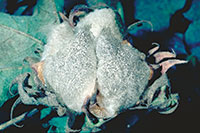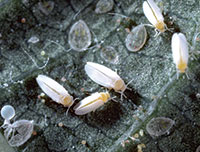

|

|
|
2014 Highlights: UC IPM Annual ReportRevisiting IPM for Sweetpotato Whitefly Prevents Sticky Cotton
Honeydew and sooty mold on a cotton boll. (Photo by J. Clark) 
Whitefly adults and nymphs. Sweetpotato whitefly is a major problem in California’s southern desert and in the San Joaquin Valley. (Photo by J. Clark) IN BRIEF
Minimizing sticky cotton remains a critical goal for San Joaquin cotton. After decades of being managed with IPM, sweetpotato whitefly has become a serious problem again in some areas of the San Joaquin Valley. This late season pest can severely reduce the quality of cotton lint by depositing honeydew—sticky insect excrement—resulting in sticky cotton. Sticky cotton gums cotton gins and can result in spinning mill shut downs to clean the machinery for up to a week or more. In today’s economy that delay can cause the mill to remain closed. Once a region has developed a poor reputation due to sticky cotton, it is difficult to recover its market share. UC IPM Advisor Pete Goodell helped organize meetings and went out in the field to consult with pest control advisers and growers. He emphasized the critical nature of sticky cotton and how to prevent it by detecting, evaluating, and managing whitefly according to the well established University of California’s Pest Management Guidelines: Cotton. New pest control advisers were not familiar with IPM methods for whitefly and so management actions were not done in time to keep numbers from increasing. Meetings were organized with other UC Cooperative Extension farm advisors, pest control advisers, and the California Cotton Ginners Association. In addition to meetings, a recorded presentation was developed in partnership with Cotton Incorporated and the Pest Management Network. The presentation covers the problem of sticky cotton, the IPM approach, whitefly identification and biology, whitefly damage, and whitefly management. Using IPM practices prevents damage and loss in agricultural crops. Where whitefly has been a problem and is not managed properly, ginning can be three times the normal cost. Cooperatives, brokers, and merchants may reject the lint completely, resulting in a complete loss for the grower. Goodell’s presentations and field consultations increase pest control advisers’ knowledge of IPM for whitefly in cotton. Using good IPM practices, cotton can be protected from whitefly contamination, maintaining cotton lint quality and grower profit. The efforts this year strengthened the partnership and commitment of UC, pest control advisers, and industry to work together to solve pest management problems. |